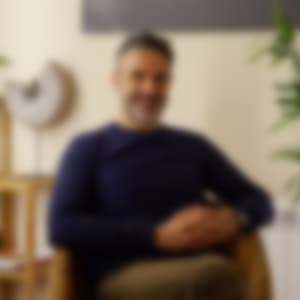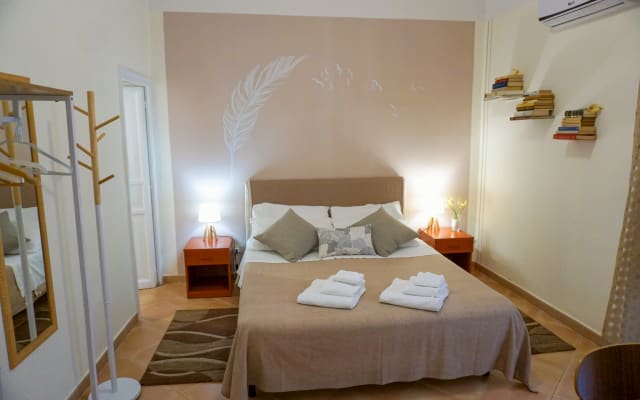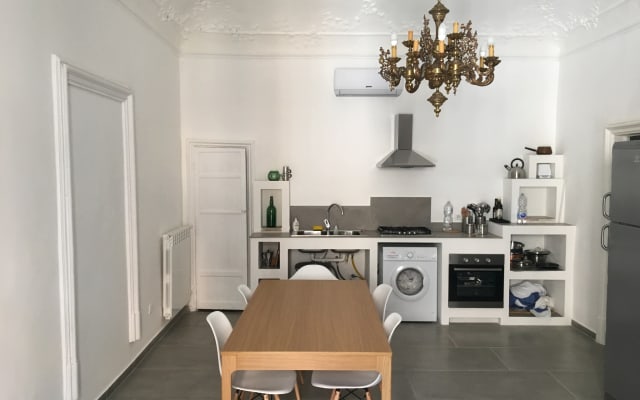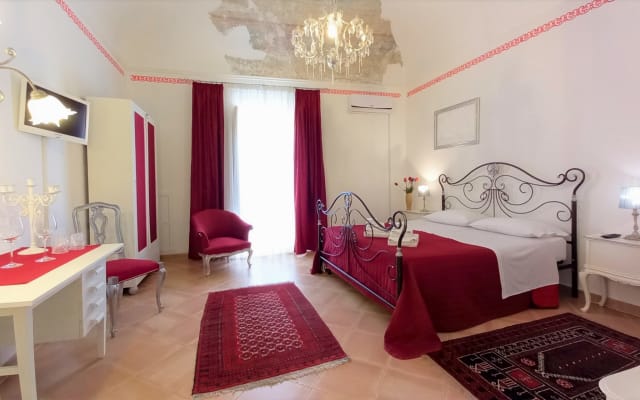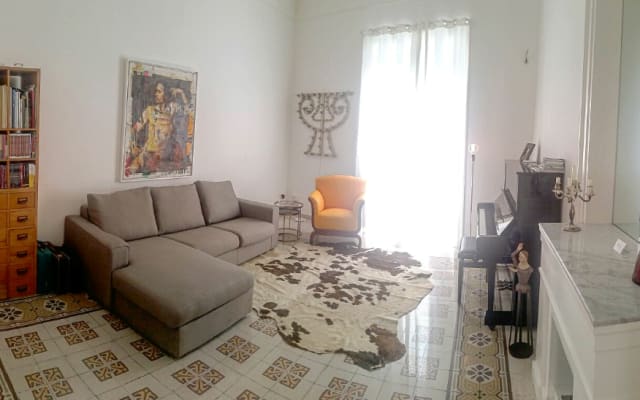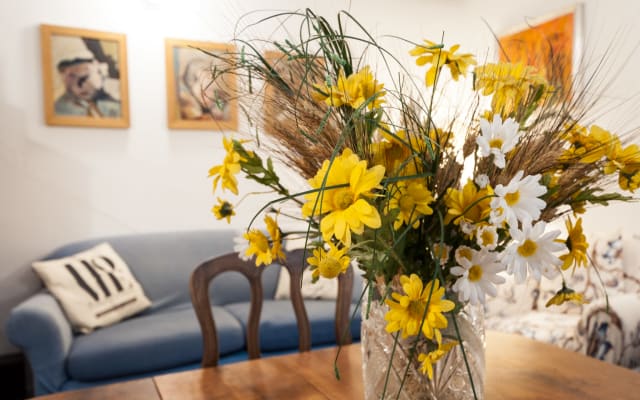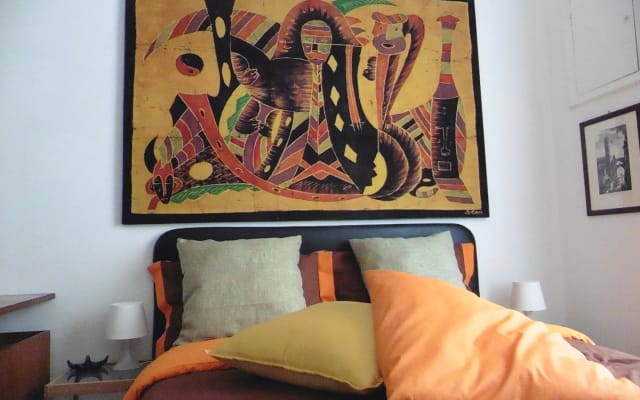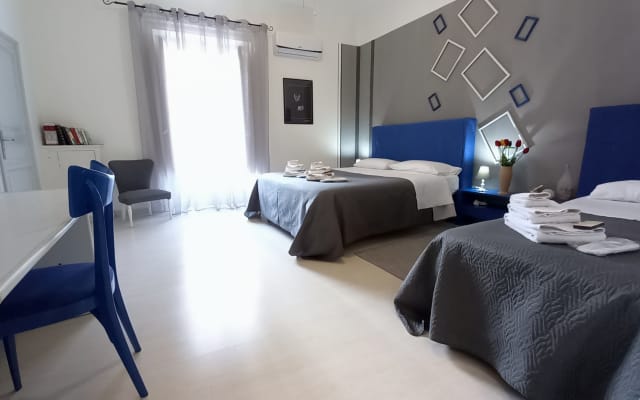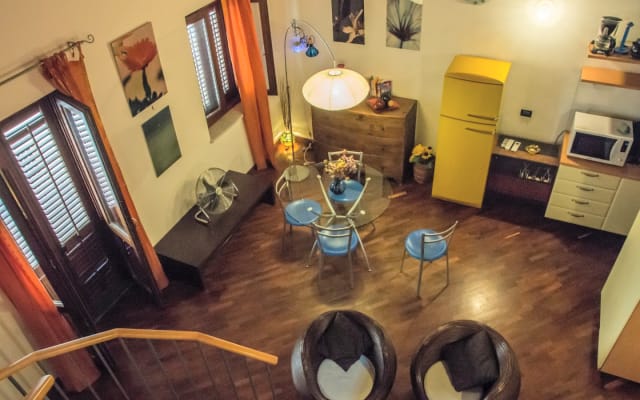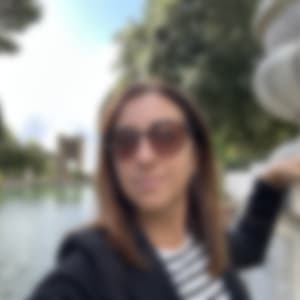-
Entire place
-
4 guests
-
2 bedrooms
-
1 bathroom
-
2 beds
- Host shares gay local tips
- LGBTQ+ venues nearby
- Wi-Fi
Why book with misterb&b?
About the Place Initially in English, this text was translated via a machine translation service and may contain inaccuracies or errors.
the apartment is located opposite the entrance to the historic market called Ballarò, close to all the most important monuments, adjacent to the central Via Maqueda, one hundred meters from the station, from where connections to the main localities of the island and the seaside resorts of the city depart
the apartment is located opposite the entrance to the historic market called Ballarò, close to all the most important monuments, adjacent to the central Via Maqueda, one hundred meters from the station, from where connections to the main localities of the island and the seaside resorts of the city depart
Amenities
- Host shares gay local tips
- LGBTQ+ venues nearby
- Wi-Fi
- Air conditioning
- Kitchen
- TV
- Essentials
- Hair dryer
- Iron
Nearby Attractions Initially in English, this text was translated via a machine translation service and may contain inaccuracies or errors.
The neighborhood
I' apartment is located in front of the entrance to the historic market of palermo called ballarò, close to all the main monuments of palermo, adjacent to the central via maqueda, one hundred meters from the central station, from where connections to the main locales of the island and to the seaside resorts of the city depart.
A tour of the surrounding area
Tourist Info
To visit Palermo is to plunge into the deepest and most intense heart of Mediterranean culture. In this sunny land, numerous civilizations have set the pace, deeply marking its architectural and monumental layout, but above all, generating a cultural alchemy that is rich in suggestion.
Palermo's historic center, consisting of what was the city enclosed within the 16th-century walls, is divided by two streets that intersect at Piazza Vigliena, creating a cross called "the baroque cross" (the Quattro Canti, also known as the "Theater of the Sun"): Via Maqueda and Corso Vittorio Emanuele. These two streets create four historic neighborhoods known as the four mandamenti: Kalsa (or Tribunali), La Loggia (or Castellammare), Seralcadio (or Monte di Pietà), and Albergheria (or Palazzo Reale).
Currently within these districts are located the city's historic markets.
For more Tourist Information ********
_____________________________________________________________________
Some of Palermo's most significant monuments include:
- the Teatro Politeama Garibaldi, is the first, in order of time, of the great theaters that arose in Palermo in the second half of the 19th century. Profoundly innovating theatrical typology and construction techniques, the Politeama was the result of a special attention to Hellenism and Greek and Roman polychrome architecture, investigated and studied first in Pompeii and Herculaneum, and then in Sicily, in Selinunte and Agrigento. The result is a rare example in the panorama of architecture of the second half of the 19th century in Italy, where the technological avant-garde of iron structures finds application, complex and elegant, coupled with an artistic experience derived from the interpretation of Greek-Sicilian forms brought back to a refined polychromy.
- Palermo's Teatro Massimo Vittorio Emanuele opened its doors to the public on the evening of May 16, 1897. The second largest theater in Europe (second only to the Paris Opera),it is one of the largest in the world, seating up to 1,300 people. An imposing neo-classical building introduced by a triangular pediment on six columns that echo the pronaos of a temple. Behind it is a large dome resting on a high drum. It was begun by Giovanni Battista Basile in 1875 and finished by his son Ernesto, who also designed the two characteristic Art Nouveau kiosks in front of the theater.
- The Quattro Canti. At the intersection of Palermo's two main streets is this widening at whose four corners rise the convex facades of beautiful seventeenth-century buildings with a classical division of three superimposed orders (Doric, Ionic and Corinthian) with, in the center, fountains surmounted by statues of the four seasons. In the niches of the upper orders, however, are statues of Spanish kings and, at the highest level, those of Palermo's patron saints, Saints Christina, Nymph, Olive and Agatha, later supplanted by Saint Rosalie. The intersection also marks the four zones into which Palermo was once divided: the Royal Palace, Mezzomonreale, Castellammare and Oreto, each assigned to a saint.
- Church of the Magione, Founded in 1191 for Cistercian monks, much damaged by bombs it was later restored and partially rebuilt. It is entered through a Baroque portal. Interior with three naves on marble columns and pointed arches, in the floor tomb slabs of Teutonic knights. Works of art inside include: two 16th-century stoups on either side of the entrance,a 16th-century Virgin and Child. In the right apse a 16th-century tabernacle and a Madonna painted on slate, possibly 16th-century.
- the Palace of the Normans, also known as the Royal Palace, which is now the seat of the Sicilian region and preserves inside it the most significant monument of Arab-Norman art, namely the Palatine Chapel, erected by Roger II in the 12th century and entirely covered with sparkling golden mosaics and inlays.
- the Church of San Giovanni degli Eremiti, erected on the ruins of a pre-existing religious building in the 12th century, is one of the most significant testimonies to the Arab presence in Palermo, and this can be seen especially in the red domes and numerous ogival arches that decorate the interior of the church.
- the Cathedral, is of thrilling majesty with its gugliate towers, its mullioned windows with two lights, and its interlaced and ogival arches. Built in 1184, it retains its original structure despite successive alterations over the centuries, the main one of which took place in the late 1700s with the addition of aisles and the Baroque dome.
- the Martorana, (S.Maria dell'Ammiraglio) is "The most beautiful monument in the world" according to the Arab traveler Ibn Giubair. Founded in 1143, it owes its sobriquet to being ceded, in the Aragonese period, to the monastery founded by Eloisa Martorana. Among the magnificent gold-backed Byzantine mosaics that cover it entirely are Roger II crowned by Christ and George of Antioch at the feet of the Virgin. The four-story bell tower, adorned with mullioned windows, small columns and colored inlays, is also very beautiful. Of note is the tower with the Arab-Norman style bell tower.
- Palazzo Abatellis, built in the 15th century and now home to the National Gallery of Sicily, which houses valuable works by Sicilian artists such as Antonello da Messina (15th century) and Francesco Laurana (15th century).
- the Zisa Castle, a 12th-century building, dates from the period of Norman rule in Sicily. Its construction was begun under the reign of William I and completed under that of William II. The Zisa of its origins was a summer residence created in the vicinity of the city for the sovereign's rest and recreation. The name Zisa is probably derived from al-Ayz (meaning noble, glorious, magnificent in the Arabic language).
- the Parco della Favorita, one of Palermo's public parks that was once the hunting ground of King Ferdinand IV, is also embellished with a number of buildings where cultural and social activities take place.
Visiting Palermo means immersing oneself in the deepest heart of the Mediterranean culture. In this sunny land, numerous cultures followed one another, deeply marking the architectural and monumental structure, and above all, creating a cultural, richly evocative chemistry. In Palermo we can admire many buildings that still today show the many influences to which the city has been exposed to in the past centuries.
For other Tourist Information ********
_____________________________________________________________________
Among its most significant monuments Palermo note:
- the Teatro Politeama Garibaldi, the first, chronologically, of the great theatres that rose in the second half of the 19th Century. Profoundly innovating the theatrical typology and its building techniques, the Politeama was the result of a particular attention toward Hellenism and polychromic Greek and Roman architecture, probed and studied first in Pompeii and Herculaneum and then in Sicily, in Selinute and Agrigento. The result is a rare example of the Italian architectural scenario of the second half of the 19th century, where technologic vanguard, complexity and elegance find their way, with its iron structures, along with an artistic experience derived from the interpretation of Greek-Sicilian forms, brought back to a refined polychromy.
- the Teatro Massimo Vittorio Emanuele of Palermo opened its doors to the public on the evening of the 16th May 1897. Second theater in Europe (second only to the Opera de Paris), is one of the biggest in the world and can contain up to 1,300 people. An imposing neoclassic building introduced by a triangular pediment on six columns which recreate the pronaos of a temple. To the side, a wide dome resting on a high tambour. Started in 1875 by Giovanni Battista Basile and then finished by his son Ernesto, who also planned the two characteristic liberty kiosks opposite the theater.
- the Quattro Canti (Four Corners). At the intersection of two of Palermo's main streets is a wide stretch, at the four corners of which rise the convex façades of the beautiful 17th century mansions with the classic division of the three laid upon orders (Doric, Ionic and Corinthian) with, in the middle, fountains surmounted by statues representing the four seasons. In the nichel of the superior orders are statues of Spanish Kings and, at a higher level, those of the Saint Patrons of Palermo, Saints Christine, Nymph, Olive and Agata, later replaced with Saint Rosalie. The crossing also marks the four areas into which Palermo was split: Palazzo Reale, Mezzomonreale, Castellammare and Oreto, each of which is entrusted to the Patron Saints.
- Chiesa della Magione (Church of the Magione), built in 1191 for the Cistercian monks, and severely damaged by bombing, was later restored and partially rebuilt. Access is through a Baroque portal. Inside is a nave with two side aisles on marble columns and pointed arches. On the floor are tombstones of Teutonic knights. Among the work of arts in its interior are: two stoups at each side of the entrance, and a Virgin with the Infant Jesus, all of the 16th century. In the left apse is a shrine of the 16th Century and a Virgin painted on board, probably of the 15th Century.
- the Palazzo dei Normanni (Palace of Normans), also known as Palazzo Reale (Royal Palace), which presently hosts the Seat of the Region, preserves in its interior the most significant monument of the Arabian-Norman art, the Palatine Chapel, erected by King Roger II in the 12th Century and entirely covered with sparkling golden mosaics and inlays.
- the Chiesa di San Giovanni degli Eremiti (Church of St. John of the hermits), erected on the ruins of a pre-existing religious building in the 12th Century, is one of the most significant examples of the Arabian presence in Palermo, and this is especially recognisable in the red domes and in the numerous ogival arches that decorate the interior of the church.
- the Cathedral is of exhilarating magnificence, with its needleful towers, twin lancet windows, interwoven and ogival arches. Built in 1184, it keeps its original structure, despite the alterations that followed with the Centuries, the main one carried out in the 18th Century, with the addition of side aisles and of the Baroque dome.
- the Martorana, (S.Maria dell'Ammiraglio). According to the Arabian traveler Ibn Giubair this is "the most beautiful monument of the world." Built in 1143, owes its name to the fact the during the Aragonese age was given to the monastery founded by Eloisa Martorana. Among the magnificent golden mosaics that completely cover its walls is King Roger II, crowned by Christ, and George of Antioch at the feet of the Virgin. Also beautiful is the four-level bell tower, decorated with twin lancet windows, small columns and golden tarsia, mosaic inlaid wood. Of importance is also the Arab-Norman bell tower.
- Palazzo Abatellis, built in the 15th century, currently hosting the Galleria Nazionale di Sicilia (National Gallery of Sicily), in which highly valuable works of art by Sicilian artists are preserved, among which are Antonello da Messina (15th century) and Francesco Laurana (15th century).
- the Castello della Zisa, (The Zisa Castle), 12th Century, dates back to the Norman domination period in Sicily. The construction began under the reign of William I and ended under the reign of William II. The Zisa was originally a summer residence, built in the vicinity of the city for the king's relaxation and amusement. The name Zisa probably comes from the Arabic al-Ays, meaning noble, glorious, magnificent.
- the Parco della Favorita, is one of Palermo's public gardens, once shooting ground of King Ferdinand IV. It is enriched with a few buildings in which cultural and social activities take place.
Visiter Palermo signifie plonger dans le coeur le plus profond et intense de la culture méditerranéenne. Dans cette terre solaire de nombreuses civilités se sont succédées et ont profondément marqué l'ordre architectonique et monumental, mais ont surtout généré une très riche alchimie culturelle de suggestions. A Palermo nous pouvons admirer de nombreux édifices qui, encore aujourd'hui, témoignent les nombreuses influences auxquelles la ville a été exposée dans les siècles passés. Voici quelques-uns des monuments les plus importants de Palermo:
Pour d'autres renseignements touristiques ********
_____________________________________________________________________
- Le Théâtre Politeama Garibaldi est le premier, au niveau du temps, des grands théâtres érigés à Palermo pendant la deuxième moitié du 19ème siècle. Innovant profondément la typologie théâtrale et les techniques constructives, le Politeama fut le fruit d'une attention particulière vers l'hellénisme et l'architecture polychrome grecque et romaine, étudiée en premier lieu à Pompei et Ercolano, et ensuite en Sicile, à Selinunte et Agrigento. Le résultat est un rare exemple dans le panorama de l'architecture de la deuxième moitié du 19ème siècle italien, où est appliquée l'avant-garde technologique des structures en fer, complexe et élégante, accouplée à une expérience artistique dérivée de l'interprétation de formes greco-sicules reconduites à une polychromie raffinée.
- Le Théâtre Massimo Vittoro Emanuele de Palermo ouvrit les portes au public le 16 mai 1897 dans la soirée. Deuxième théâtre d'Europe (Après l'opéra de Paris), il est un des plus grands théâtres du monde, il peut accueillir jusqu'à 1,300 personnes. Une construction imposante néoclassique introduite par un fronton triangulaire sur six colonnes qui reproposent le vestibule d'un temple. Dans le fond, une ample coupole appuyée sur un grand tambour. Sa construction fut commencée par Giovanni Battista Basile en 1875 et fut terminée par son fils Ernesto, qui conçut également les deux petits kiosques caractéristiques de style liberty devant le théâtre.
- Les Quattro Canti. A l'intersection des deux rues principales de Palermo nous trouvons cet élargissement. Aux quatre angles de cet élargissement s'élèvent les façades convexes des beaux palais du ********ième siècle à la classique subdivision aux trois ordres superposés (dorique, ionique et corinthien) avec, au centre, des fontaines surmontées par les statues des quatre saisons. Dans les niches des ordres supérieurs se trouvent en revanche les statues de rois espagnols et, au niveau supérieur, celles des protectrices de Palermo, les Saintes Cristina, Ninfa, Oliva et Agata, surmontées de Sainte Rosalia. Le croisement marque également les quatre zones où, dans le passé, Palermo était divisée : Palazzo Reale, Mezzomonreale, Castellammare et Oreto, chacune desquelles étaient confiées à une sainte.
- Eglise de la Magione. Fondée en 1191 par des moines cisterciens, elle fut endommagée par les bombes et successivement restaurée et partiellement reconstruite. On y accède par un portail baroque. Zone intérieure à trois nefs sur colonnes marbrées et arcs brisés en lancette, et pierres tombales des chevaliers teutoniques sous le carrelage. Parmi les oeuvres d'art qui se trouvent dans l'église il y a : deux bénitiers du XVIème siècle sur les côtés de l'entrée et une Vierge avec l'Enfant du XVIème siècle. Dans l'abside à droite, un tabernacle du XVIème siècle et une Madone peinte sur un tableau, remontant probablement au seizième siècle.
- Palazzo dei Normanni, connu également comme Palais Royal, qui est aujourd'hui le siège de la région Sicilienne et qui conserve le monument le plus significatif de l'art arabo-normand, c'est à dire la Chapelle Palatine, érigée par Ruggero II dans le XIIème siècle et entièrement recouverte de mosaïques étincelants dorés et de marqueterie.
- l Eglise de San Giovanni degli Eremiti, érigée sur les ruines d'un bâtiment religieux préexistant du XIIème siècle, est un des témoignages plus significatifs de la présence arabe à Palermo, et ceci se note surtout dans les coupoles rouges et dans les nombreux arcs ogivaux qui décorent l'intérieur de l'église.
- la Cathédrale est d'une majestuosité enthousiasmante avec ses tours en flèche, ses fenêtres géminées, des arcs croisés et ogivaux. Edifiée en 1184, elle conserve sa structure originaire malgré les altérations qui s'ensuivirent les siècles passant dont la principale à la fin du 18ème siècle avec l'ajout des nefs latérales et de la coupole baroque.
- la Martorana, (S.Maria dell'Ammiraglio) est "Le plus beau monument du monde" selon le voyageur arabe Ibn Giubair. Fondée en 1143, elle doit son surnom au fait d'avoir été cédée, pendant la période aragonaise, au monastère fondé par Eloisa Martorana. Parmi les magnifiques mosaïques byzantins sur un arrière plan en or qui la recouvrent entièrement, il y a Ruggiero II couronné par le Christ et Giorgio d'Antiochia aux pieds de la Vierge. Le clocher à quatre étages, ornés de fenêtres géminées, petites colonnes et marqueteries colorées, est très beau lui aussi. La tour avec le clocher de style arabo-normand est d'intérêt remarquable.
- Palazzo Abatellis, édifié au XVème siècle et aujourd'hui siège de la Galerie Nationale de Sicile, dans laquelle sont conservés des oeuvres de valeur d'artistes siciliens, comme Antonello da Messina (XVème siècle) et Francesco Laurana (XVème siècle).
- Le Château de la Zisa, édifice du XIIème siècle. Il remonte à la période de la domination normande en Sicile. Sa construction commença sous le règne de Guglielmo I et finit sous le règne de Guglielmo II. La Zisa originairement était une résidence d'été créée dans les alentours de la ville pour le repos et le divertissement du souverain. Le nom Zisa dérive probablement de al-Ayz (qui, en langue arable, signifie noble, glorieux, magnifique).
- Le Parc de la Favorita, un des parcs publics de Paermo qui dans le passé était la réserve de chasse du roi Ferdinando IV. Il est en outre enrichi de certains édifices dans lesquels se déroulent des activités culturelles et sociales.
Die Besichtigung Palermo bedeutet im tiefen und heftigen Herzen der Mittelmeerkultur einzutauchen. In diesem Sonnenland die Völker verfolgten sich ohne Pause und haben die Ordnung architektonisch und monumental charakterisiert, aber vor allem haben sie eine kulturelle Alchimie sehr reich von Eindrucken erregt.
Für andere Tourist-Information ********
_____________________________________________________________________
Noch Heute zeigen viele Monumenten den Einfluss dieser Völker und unter den wichtigsten Monumenten finden wir:
- "Teatro Politeama Garibaldi" ist Mitte des ******** Jahrhunderts geboren. Das Theater ist Frucht von einer speziellen Beachtung des Hellenismus und wurde von griechischer und römischer Architektur aus Pompej, Ercolano, Selinunte und Agrigent inspiriert. Der kreisförmigen Fassade sind Säulengänge vorgesetzt, im Erdgeschoss mit dorischen Säulen und im Obergeschoss mit ionischen Säulen und der Eingang ist als Triumphbogen gestaltet
-Das neoklassizistische "Teatro Massimo" gehört zu den größten Opernhäusern Europas und zweite an der pariser Oper..Das Teatro Massimo wurde am 16. Mai 1897 mit der Aufführung von Verdis Oper Falstaff eröffnet. Der Bau des Theater wurde vom Architekten Giovanni Battista Basile geleitet und 1875 angefangen. Nach dem Tot des Architekten Giovanni Battista Basile wurde der Bau von seinem Sohn Ernesto Basile fortgesetzt. Die Fassade des Theaters zeigt Stilelemente des Historismus. Der Haupteingang ist ein Portikus aus sechs korinthischen Säulen vorgelagert. Zum Portikus führt eine monumentale Freitreppe, an der auf beiden Seiten zwei Löwenskulpturen liegen. Der Opernsaal ist mit einer großen Kuppel überspannt. Der Saal wurde von verschiedenen Künstlern ausgestaltet und kann bis 1,300 Personen aufnehmen.
- "I Quattro canti" sind die Kreuzung der Hauptstraßen Corso Vittorio Emanuele und Via Maqueda. Die Barockpaläste an den vier Ecken haben konkav geschwungene Fassaden. In den Sockelnischen befinden sich Brunnen, deren Fontänen und Statuen die vier Jahreszeiten symbolisieren. Im mittleren Bereich stehen in zentralen Nischen die Statuen der spanischen Königen. Die Statuen im oberen Bereich stellen die vier Schutzheiligen der damaligen Stadtviertel waren: Agatha , Cristina, Ninfa und Oliva, und der Patron S.Rosalia. Die Brunnen und Skulpturen werden von Säulen eingerahmt, die von ******** nach oben der Ordnung dorisch , ionisch und korinthisch folgen.
-Die Kirche "Santissima Trinità della Magione" ist eine der letzten Kirchen, die die Normannen in Palermo erbauten . Sie wurde 1191 bei die Zisterzienser erbaut. Sie bestehen aus eine barock Pforte, dreischiffige mit marmornen Säule und Spitzbogen und der Fußboden mit dem Graben von teutonischen Rittern. Im Inneren der Kirche gibt es: eine Jungfrau mit Kind vom XVI Jahrhundert., ein Tabernakel vom XVI Jahrhundert und eine Muttergottes vielleicht aus dem sechzehnten Jahrhundert.
- "Palazzo dei Normanni" bekannt auch als "Palazzo Reale" ist heute das Parlament von Sizilien. Im Inneren des Palastes befindet sich die spektakuläre "Cappella Palatina", die von Roger II. im arabisch-byzantinisch-normannischen Stil errichtet wurde. Diese Hofkapelle hat die Wände mit Goldgrundmosaiken bedeckt
- "San Giovanni degli Eremiti" wurde XII Jh. erbaut. Die Architektur von San Giovanni degli Eremiti stellt eine Symbiose aus normannischen und arabisch-byzantinischen Elementen dar und die fünf Roten Kuppeln, die den nüchternen Baukörper beherrschen, sind Ausdruck dieser Stilmischung.
-Der Bau der Kathedrale wurde 1184 im normannisch-arabischen Stil errichtet und erfuhr im Lauf der Jahrhunderte mehrere Umbauten. Im Inneren der Kathedrale gibt es die Gräber der Staufer.
- "Santa Maria dell'Ammiraglio" (heilige Maria vom Ammiratus ), auch "La Martorana" genannt, wurde 1143 von Giorgio di Antiochia , dem Ammiratus König Rogers II. ,erbaut. Der arabisch Reisende Giubair sagt dass "La Martorana" "die schönste Kirsche der Welt" ist. Das Innere der Kirche ist dreischiffig. Die Kirche ist mit byzantinischen Goldgrundmosaiken überzogen und die zwei wichtigsten Darstellungen sind: Giorgio di Antiochia, der sich betend vor der Muttergottes zu Boden wirft, und Roger II., der von Christus selbst zum König gekrönt wird.
- "Palazzo Abatellis" ist heute die Regionalgalerie Siziliens, das größte Kunstmuseum. Im Inneren des Museums gibt es Kunst von Antonello da Messina ( XV Jh.) und Francesco Laurana ( XV Jh.).
- "Castello della Zisa" ist ein Schloss im Westen von Palermo, das den normannischen Königen von Sizilien als Sommerresidenz diente. "La Zisa" wurde unter Wilhelm I. begonnen und unter dessen Sohn Wilhelm II. fertiggestellt. Der Name des Schlosses hat seinen Ursprung im Arabischen. Er leitet sich von "aziz," zwar glanzvoll ab.
- "Parco della Favorita" ist die größte Parkanlage von Palermo und war das Revier von Ferdinand IV.
Visitar Palermo significa sumergirse en el más profundo y el más intenso corazón de la cultura mediterránea. En esta tierra se sucedieron diferentes culturas que le han marcado profundamente en su estructura arquitectónica y monumental, y que sobre todo han generado una alquimia cultural muy rica de sugestiones. Hoy día en Palermo podemos admirar muchísimos edificios que testimonian las diferentes influencias culturales que se han impuesto en la ciudad a lo largo de los siglos pasados
Para otros de Información Turística ********
_____________________________________________________________________
Entre los monumentos más significativos de Palermo recordamos:
El Teatro "Politema Garibaldi", es el primero, en orden cronológico, de los grandes teatros nacidos en Palermo durante la segunda mitad de 1800.
Con sus profundas inovaciones en la tipología teatral y en la tecnicas constructivas, El Politeama es el fruto de una particular atención al helenismo y a la arquitectura polícroma griega y romana, indagada y estudiada primero en Pompei y Ercolano, y después en Sicilia, en Selinunte y Agrigento.
El resultado es un raro ejemplo dentro del panorama arquitectónico de la segunda mitad de 1800 italiano, donde encuentra su lugar, compleja y elegante, la vanguardia tecnológica con sus estructuras de hierro, junto a una experiencia artística que procede de la interpretación de formas griego-sículas reconducidas a una refinada policromía.
El teatro "Massimo Vittorio Emanuele" abrí las puertas al público la noche del 16 de Mayo de 1897. Segundo teatro de Europa (segundo sólo a la "Opera" de París), es uno de los mayores del mundo, puede acoger hasta 1300 personas.
Una imponente construcción neoclásica introducida por un frontón triangular sobre seis columnas que vuelven a proponer el pronaos de un templo.
Fue empezado por Giovanni Battista Basile en 1875 y terminado por el hijo Ernesto, que ideó también los dos característicos quioscos de estilo floreal delante del teatro.
" I Quattro Canti." En el cruce de las dos calles principales de Palermo se encuentra este ensanche donde en los cuatros respectivos ángulos se elevan las fachadas convexas de palacios del siglo diecisiete caracterizados por la subdvisión clásica en tres órdenes sobrepuestos (dórico, jónico y corintio) con, en el centro, fuentes coronadas por las estatuas de las cuatros estaciones.
Puestas en los nichos de los órdenes superiores se encuentran en cambio las estatuas de reyes españoles y, a un nivel màs alto, aquellas de las protectoras de Palermo, "Santa Cristina, Ninfa, Oliva y Agata", después reemplazada por Santa Rosalia.
El cruce marca también las cuatros zonas en las cuales, antiguamente, estaba repartida la ciudad: Palacio Real, "Mezzomonreale, Castellammare y Oreto";cada una delegada a una Santa diferente.
La Iglesia de "La Magione", fue fundada en 1191 por los monjes cisterciences, muy perjudicada por las bombas, en seguida ha sido restaurada y parcialmente ******** accede por un portal barroco, en el interior hay tres navas con columnas marmóreas y arcos apuntados, en el suelo losas tumbales de caballeros teutónicos y algunas obras artísticas como dos pilas del siglo XVI a los lados de la entrada, una Virgen con el Niño del siglo XVI,
en el ábside derecho un tabernáculo del siglo XVI y una Virgen pintada sobre pizarra quizás del mismo siglo.
El Palacio de "I Normanni", (Palacio de los Normandos) conocido también como Palacio Rel, hoy sede de la Asamblea Regional Siciliana, conserva en su interior uno de los monumentos más representativos del arte árabe-normando, la "Cappella Palatina"(Capilla Palatina) fundada por Rogelio II de Sicilia en el siglo XII y totalmente recubierta con brillantes mosaicos de oro e incrustaciones.
La Iglesia de "San Giovanni degli Eremiti" (San Juan de la Ermita) erigida sobre las ruinas de un preexistente edificio religioso en el siglo XII, es uno de los más significativos testimonios de la presencia árabe en Palermo, gracias a elementos como las cúpulas rojas y a los arcos ojivales que decoran el interior de la iglesia.
La Catedral, es un edificio de majestuosidad apasionante con sus torres pinaculadas, sus ajimeses, sus arcos entrelazados y ojivales.
Edificada en 1184 conserva su estructura original a pesar de las alteraciones que se subsiguieron a lo largo de los siglos, entre las cuales la principal, al final de 1700 , aportó la añadidura de las navas laterales y de las cúpulas barrocas.
"La Martorana" (o "S.Maria dell'Ammiraglio") es "el monumento más hermoso del mundo" dijo el viajador árabe Ibn Giubair. Fue fundada en 1143, tomó ese nombre después que fue cedida, en edad aragonesa, al monasterio fundado por Eloísa Martorana.
Entre los personajes representados en los marvillosos mosaicos bizantinos aparecen Rogelio II encoronado por Cristo y el almirante Gorge de Antioquia a los pies de la Virgen. Muy hermoso también es el campanario de cuatros pisos, ornado con ajimeses, pequeñas columnas y taraceas pintadas, así como la torre con el campanario de estilo árabe-normando.
Palacio "Abatellis", edificado en el siglo XV, hoy es la sede de la Galería de Arte Nacional de Sicilia, donde se pueden admirar obras muy preciadas de artistas sicilianos como Antonello da Messina (siglo XV) y Francesco Laurana (siglo XV).
EL Castillo de "La Zisa", edificio del siglo XII, remonta al período de la dominación normanda en ******** construcción fue empezada bajo el reino de Guillermo I de Sicilia y llevada a cabo bajo el de Guillermo ******** origen "La Zisa" era una residencia veraniega creada cerca de la ciudad para el descanso y la diversión del rey.
El nombre "Zisa" procede con mucha probabilidad de la palabra "Al-Ayz", que en árabe significa noble, glorioso, magnífico.
El Parque de "La Favorita", uno del los parques públicos de Palermo, nació como reserva de caza del rey Fernando IV, y es enriquecido además con edificios donde tienen lugar actividades culturales y sociales.
The neighborhood
I' apartment is located in front of the entrance to the historic market of palermo called ballarò, close to all the main monuments of palermo, adjacent to the central via maqueda, one hundred meters from the central station, from where connections to the main locales of the islan...
Be the first to review this property!
The hosts took the time to best showcase their accommodation. Their home is now ready for your stay and they look forward to welcoming you as their first misterb&b guest!About the Host
Property Rules Initially in English, this text was translated via a machine translation service and may contain inaccuracies or errors.
Additional rules
In order to make the service more functional and pleasant, we point out some small rules to be observed:
guests are requested to communicate their arrival time at least 24 H in advance;...
upon arrival each guest must hand over a valid ID,
rooms may be occupied after 2:00 p.m. and vacated by 10:00 a.m.;........
the keys will be given to the guest who must keep them responsibly and must be returned at the end of the stay;.........
the guest is not bound by any return time, however, the utmost discretion towards other guests is requested;.........
smoking is prohibited inside the dwelling,
guests are asked not to leave valuables unattended.
air conditioning service is extra and must be requested on site. the cost is 15 euros per day
If they book two people will be provided a twin bed if they have the need to have two separate beds they will have to communicate it before and there will be an additional cost of 20€
--------------------------------------------------------------------------------------------
Additional rules
To make the service more functional and pleasant, there are some small rules to be respected:
guests are advised to communicate their arrival time with at least 24 H in advance; ...
upon arrival each client must provide a valid ID,
the rooms can be occupied after 14:00 and vacated by 10:00; ........
the keys will be delivered to the guest who will have to keep them with responsibility and must be returned at the end of the stay; .........
the guest is not bound by any return time, however maximum discretion is requested with respect to the other guests; .........
it is forbidden to smoke inside the house,
guests are requested not to leave valuables unattended.
the air conditioning service is an extra and must be requested on site. the cost is 15 euros per day
If two people book, a double bed will be provided if they need to have two separate beds they will have to communicate it first and there will be an additional cost of € 20
--------------------------------------------------------------------------------------------
Règles supplémentaires
Pour rendre le service plus fonctionnel et agréable, il y a quelques petites règles à respecter:
il est conseillé de communiquer son heure d'arrivée au moins 24 heures à l'avance; ...
à l'arrivée, chaque client doit fournir une pièce d'identité valide,
les chambres peuvent être occupées après 14h00 et libérées pour 10h00; ........
les clés seront remises à l'invité qui devra les garder avec responsabilité et devra être rendu à la fin du séjour; .........
l'invité n'est lié par aucune heure de retour, cependant une discrétion maximale est demandée à l'égard des autres invités; .........
il est interdit de fumer à l'intérieur de la maison,
les clients sont priés de ne pas laisser d'objets de valeur sans surveillance.
le service de climatisation est un supplément et doit être demandé sur place. le coût est de 15 euros par jour
Si deux personnes réservent, un lit double leur sera fourni si elles ont besoin de deux lits séparés, elles devront d'abord le communiquer et il y aura un coût supplémentaire de 20 €
Additional rules
In order to make the service more functional and pleasant, we point out some small rules to be observed:
guests are requested to communicate their arrival time at least 24 H in advance;...
upon arrival each guest must hand over a ...
Conditions
Cancellation Policy


You can contact Ferdinando through the Contact Host button on this page. If you've already booked, go to My trips.
Travel with peace of mind while connecting with the gay community. As the largest gay hotelier in the world, misterb&b guarantees secure payments, Booking insurance Coverage, and a customer support team that is at your service.
It is up to the host to ask for a security deposit. If there is a security deposit on the listing, the amount is displayed underneath the price per night.
A confirmation e-mail with the contact information of your host will be sent to your e-mail address upon a successful booking. Log in to your misterb&b account and visit My trips. Here you will find the status and details of all your bookings and booking requests.
More about gay Palermo









